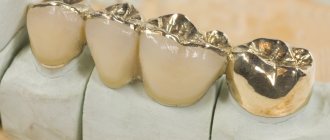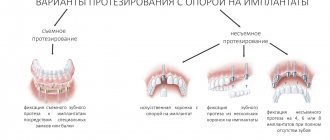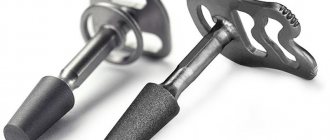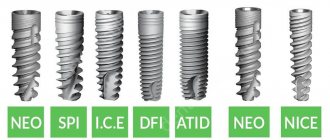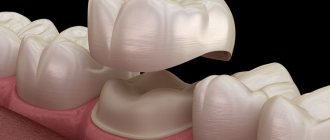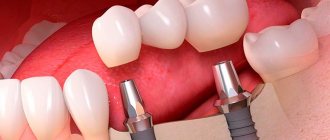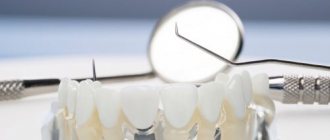The most modern type of prosthetics is now considered to be dental implantation.
If one or more teeth have been lost due to untreated caries, pulpitis or another oral disease, you should think about implantation. This type of prosthetics is ideal for you if you are a supporter of modern approaches and a supporter of progress in medicine, value comfort and lead an active lifestyle.
The undeniable advantages of dental implants are their qualities such as:
- creation of a permanent, non-removable prosthesis;
- complete replacement of not only the tooth, but also the root;
- preventing bone tissue atrophy at the site of tooth loss;
- the implant has its own safety margin;
- The implant not only does not require support from neighboring teeth, but can also serve as support in a combination of various types of prosthetics;
- the implant installation process does not require grinding of adjacent teeth;
- you will feel the familiar taste of food and will not experience discomfort from pieces getting stuck in the crowns;
- the healing process occurs as quickly as possible;
- you are guaranteed to forget which of your teeth is an implant, because it will be absolutely indistinguishable.
If you experience embarrassment and irritation from the absence of a tooth or several teeth, if you are tired of wearing bulky dentures or suffer from old methods of prosthetics, then a modern method of prosthetics - DENTAL IMPLANTATION - will be your salvation! tel. 8 (495) 638-05-05
What is one-stage dental implantation?
Single-stage, or instant, implantation is a type of dental restoration where immediately after a tooth is removed, an implant is installed in its place, and all this happens during one visit. Single-stage implantation is most in demand when restoring teeth in “visible” areas, that is, where aesthetics are so important, namely in the smile area.
From a functional point of view, implantation immediately after tooth extraction is more preferable than a two-stage technique in cases where it is necessary to simultaneously restore several teeth. In such a situation, the instant technique significantly reduces the patient’s rehabilitation time, and also allows the installation of a temporary structure with which the patient can chew without problems and immediately.
Recovery postoperative period
After the operation, the recovery period begins, the person has solved his problem and now there is an implant instead of a damaged tooth. How to care for it and what should you be wary of on the doctor’s recommendation until the tooth finally begins to feel like your own?
For the first few days, the patient will experience slight swelling, which will cause discomfort. This is normal because surgery was performed. It is worth avoiding excessive chewing loads during this period and carefully monitoring oral hygiene using special antiseptics. During the first month, the discomfort goes away, and the patient forgets that he has an implant installed.
Installing an implant immediately after tooth extraction - types of surgery
There are three main types of this procedure for restoring teeth immediately after their removal. The first is instant implantation, when after installing the implant, the gums in the place of the just extracted tooth are sutured, and further manipulations are performed only after complete healing. In the second case, during immediate implantation, in addition to the implant itself, the patient is also fitted with a gum former, which helps in the future to preserve the so-called “pink aesthetics”, that is, the natural and neat appearance of the soft tissue at the implantation site. Gum formers can be standard or custom-made; which one to choose depends on the situation.
The third type of one-stage jaw implantation is the installation of an implant in place of an extracted tooth with immediate loading of the latter with a temporary crown. After the implant has healed, this temporary crown is replaced with a permanent one. This subtype of instant implantation is by far the most effective from an aesthetic point of view, as it allows you to fully restore the pleasant appearance of your smile in one visit, so that the patient does not have to walk around with a “hole” in the dentition for the entire healing period. This type of express implantation is most in demand when restoring teeth in the smile zone, that is, in the anterior region.
Details about each of the listed methods
The most important advantage in dental implantation compared to conventional prosthetics and, in fact, the only way to solve the problem of dentition correction at the end of the last century was the preservation and stimulation of bone tissue. After the loss of a tooth, only an implant can ensure the safety of its alveolar parts, which significantly improves the quality of chewing food, diction and aesthetic appearance.
Splitting of the alveolar apex
This type of bone grafting is used in cases of horizontal bone melting to expand the area for implantation. In modern dentistry, this method is used most often, since it is suitable for plastic surgery of both jaws, and also has a low cost, due to the absence of the need to use expensive bone materials and membranes.
Splitting the area of the anatomical part of the jaw that bears the tooth serves as a kind of stimulation of natural osteogenesis. Another important advantage of the method is the possibility of simultaneous implantation, which significantly speeds up the process of restoring the dentition and the natural functions of the masticatory apparatus. Even if implantation is not possible immediately for some reason, it is carried out within a couple of months at most, which still speeds up the process compared to other methods.
Bone transplantation
Implantologists use this method to expand and lift the alveolar part of the future tooth using bone tissue transplants of various origins. For this manipulation, specialists use the following type of biological materials:
- bone tissue is taken from the patient from another area of the jaw (usually in the area of the 8th tooth, where the most active osteogenesis is noted);
- it is possible to implant donor tissue, that is, fragments of bone tissue of another person, possibly deceased (cadaveric biomaterial), which is allowed in most countries of the world;
- bone tissue of cattle has also proven itself positively in the restoration process of the alveolar areas of the jaws;
- synthetic, highly adapted bone tissue, which has a high degree of engraftment and stimulation of its own osteogenesis.
The implantation of bone tissue from a donor or animal undergoes multi-stage sterilization and adaptation, but implantologists still call the most effective method autotransplantation, that is, the use of one’s own bone tissue. the main disadvantages of this type of bone grafting to be :
- the need for another operation;
- long-term healing and restoration of bone volume;
- delayed possibility of the final stage of dentition correction.
Targeted bone tissue regeneration
Targeted correction of alveolar process tissue effectively restores its width and height. The method involves the use of donor or own bone material, as well as a specific membrane that separates and protects the formation of the implant site from adverse effects. A barrier in the form of a membrane makes it possible to provide the necessary shape and volume to the deformed area of the alveolar process and protect the transplanted tissue from resorption and mechanical damage.
However, the pronounced foresight of this method in terms of limiting the area of bone restoration also has a negative side, since the upper layer of bone tissue, due to the presence of the membrane, can partially degenerate, since the connection with the circulatory system is lost. This fact is the main disadvantage of this type of bone grafting . In addition, the pricing policy also plays an important role here, which is available to very few patients, since bone material and a self-absorbing membrane require significant financial costs.
Sinus lift
The sinus lift method is used to restore the bone tissue of the upper jaw. This method is acceptable even in patients with severe bone tissue deficiency. The base of the maxillary sinuses is involved in the process, that is, some of it is filled with bone fragments, which allows for full implantation at the proper level, with guaranteed durability, high-quality chewing ability, diction and a smile.
Before the operation, the doctor carefully examines the patient for the presence of an inflammatory process in the maxillary sinuses, chronic pathologies, and any restrictions due to the anatomical features of the structure. The dentist-implantologist considers computer and magnetic resonance imaging to be the most informative means in this case, which provide a layer-by-layer image, reproduce the future sinus lifting process on the screen and determine the amount of required bone tissue.
It should be noted that all methods of bone tissue correction are performed under local or general anesthesia, and in some patients there is a need for preliminary sedation due to increased excitability in anticipation of surgery.
Immediate dental implantation and its benefits
Ensuring a beautiful appearance, especially in the frontal area, is no less important than restoring the functions of speech and chewing, and the already mentioned “pink aesthetics,” that is, a neat contour of the gums, is no less important than the correctly selected color and shape of an artificial tooth. The advantage of one-stage jaw implantation is that, regardless of whether we load the implant with a temporary crown or install a gum former, we maintain the original contour of the soft tissues. In the case of two-stage implantation, this circuit has to be restored from scratch after the implant has completely healed, which not only forces the patient to endure inconvenience during the rehabilitation period, but also does not guarantee an ideal result in the future. As for monetary costs, the price of one-stage implantation in Moscow does not exceed the cost of surgery using the classical method.
Review statistics among specialists and patients
The one-stage prosthetics method began to be used in Russia relatively recently, while in Europe such services have been provided for several years. Analyzing world statistics, you can see that this method has collected a large number of positive reviews and enjoys well-deserved trust among both doctors and patients. The problem of a missing tooth is solved in record time.
Single-stage implantation also perfectly solves the aesthetic component of the problem: there are patients who do not like the look of their own teeth. They delay visiting the dentist and go without a tooth for a long time, not deciding on implantation. In addition, many people think that implantation takes a long time and are unable to find a place for the procedure due to their busy work schedule. However, the procedure is performed quickly and the installed tooth will look aesthetically pleasing and natural. Negative reviews can only be found regarding dissatisfaction with the price: the procedure is not budget-friendly and not everyone can afford it.
What are the contraindications to immediate dental implantation?
Unfortunately, immediate implantation is not always the best option, since in some cases it is not possible to install an implant immediately after tooth extraction. For example, immediate implantation is not carried out when inflammation is observed at the site of the extracted tooth. Also an obstacle are standard contraindications to implantation, be it decompensated diabetes mellitus, severe bruxism, or uncontrolled grinding of teeth, some other chronic diseases in the acute stage or relapse, osteoporosis, heart attacks suffered less than six months ago, strokes and hypertensive crises. Smokers are also at risk. Although smoking is considered a relative, and not an absolute, contraindication, it may well cause implant failure.
In a number of other cases, immediate installation of an implant in place of an extracted tooth is possible, but immediate loading of it with a temporary crown is, unfortunately, not. Such situations include, for example, traumatic tooth extraction, a small volume of bone and soft tissue in the area where the implant is installed and its insufficiently reliable fixation in the socket, as well as a soft bone structure. In such cases, an aesthetic result is achieved by installing a gum former and attaching a temporary orthopedic structure to the teeth adjacent to the defect, hiding the “hole” in the dentition.
Photos before and after implant installation
Risks of instant dental implantation
To be absolutely frank, we have to admit that with one-stage implantation, the percentage of implant rejection is slightly higher than with two-stage implantation, but this percentage still remains negligible (provided that all standards are met). Moreover, this risk is justified, especially in cases where a quick, highly aesthetic result is required. In general, the risk of implant rejection when installed using one-stage technology is associated with the following factors:
- severe gum injury after tooth extraction;
- accumulation of plaque around the hole not protected by the gum;
- not very strong implant fixation;
- immediate loading of the implant with a temporary crown.
Price
The technique of one-stage implantation requires the use of high-quality materials and modern equipment. In addition, the highly qualified implantologist is very important. The total cost of the procedure consists of consumables, the level of the doctor and the clinic. If the clinic has its own dental laboratory, the cost of the implant will be significantly lower. The average price for a turnkey installation is 45 thousand rubles. The service life of implants reaches 25 years, provided that high-quality materials are selected and the procedure protocol is strictly followed. The best implants are those made in Sweden, Israel and the USA.


